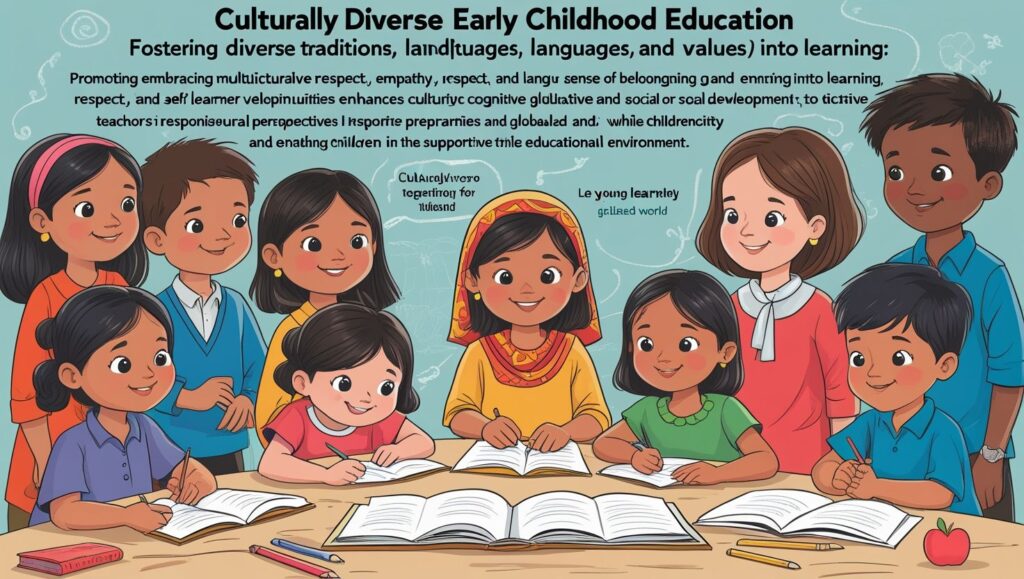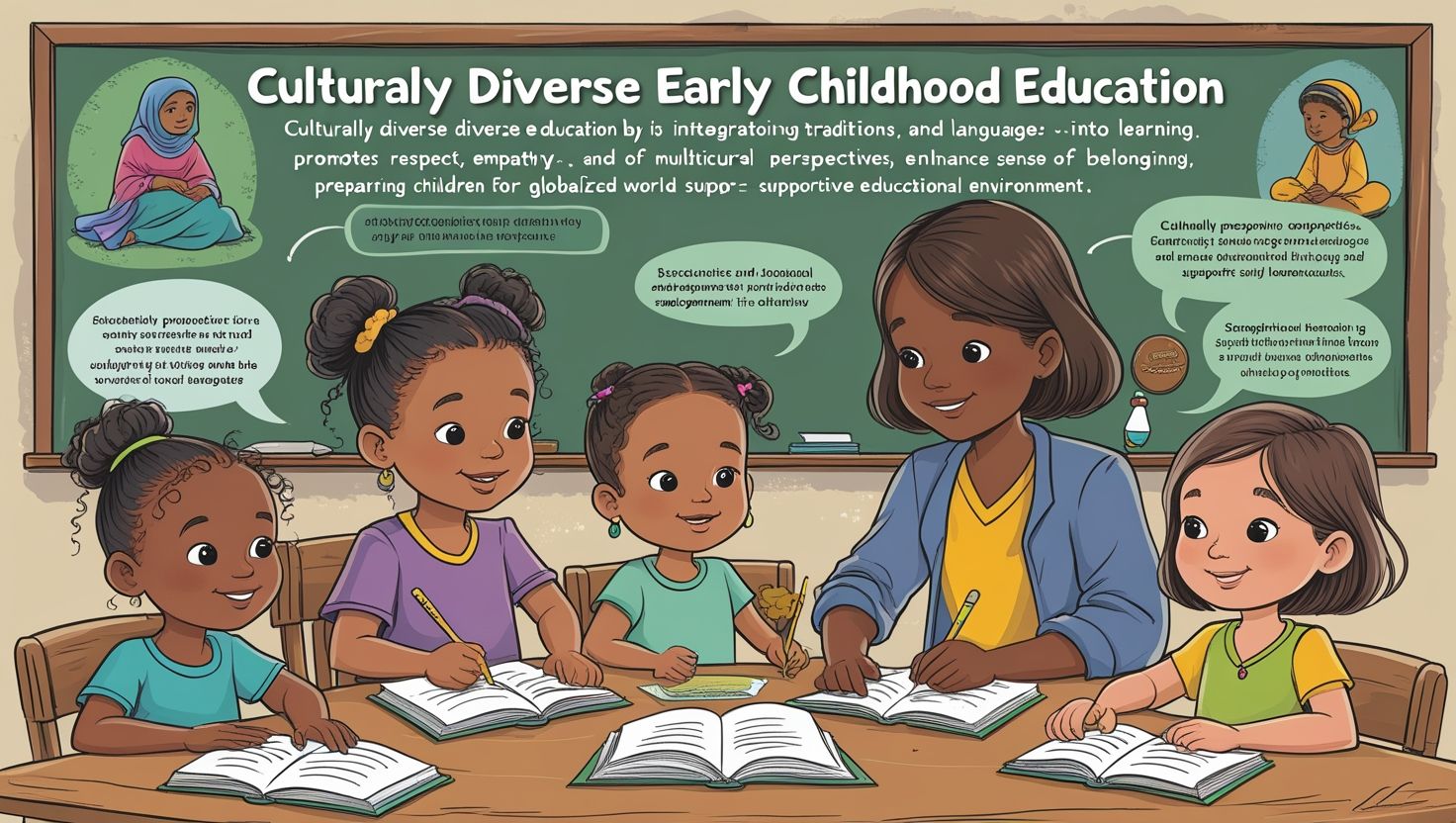Culturally Diverse Early Childhood Education, Culturally Diverse Early Childhood Education, In an increasingly globalized world, culturally diverse early childhood education has become a cornerstone for fostering inclusivity, empathy, and understanding among young learners. Early childhood, defined as the period from birth to eight years old, is a critical stage for cognitive, social, and emotional development. During this time, children begin to form their identities, values, and perceptions of the world around them. Culturally diverse education in these formative years ensures that children grow up appreciating differences, respecting varied traditions, and developing a global mindset. This approach not only benefits individual children but also contributes to building harmonious, multicultural societies.
The Importance of Cultural Diversity in Early Childhood Education
Cultural diversity in early childhood education is essential for several reasons. First, it helps children develop a sense of belonging and self-esteem. When children see their culture, language, and traditions reflected in the classroom, they feel valued and respected. This validation is crucial for their emotional well-being and confidence. Second, exposure to diverse cultures broadens children’s perspectives. It teaches them that there are multiple ways of thinking, living, and solving problems, which fosters creativity and critical thinking. Third, culturally diverse education prepares children for a multicultural world. In an era where cross-cultural communication and collaboration are increasingly important, early exposure to diversity equips children with the skills to navigate and thrive in diverse environments.
Moreover, culturally diverse education promotes empathy and reduces prejudice. When children interact with peers from different cultural backgrounds, they learn to appreciate differences and recognize commonalities. This early exposure helps break down stereotypes and fosters a sense of unity. For example, celebrating festivals from various cultures, reading stories from around the world, and incorporating multilingual activities can create an inclusive environment where every child feels represented.
Challenges in Implementing Culturally Diverse Education
Despite its importance, implementing culturally diverse early childhood education is not without challenges. One major obstacle is the lack of resources and training for educators. Many teachers may not have the necessary knowledge or tools to effectively incorporate cultural diversity into their curriculum. This can lead to superficial or tokenistic approaches, such as celebrating a few cultural holidays without delving deeper into the values and histories behind them. To address this, professional development programs should be prioritized to equip educators with the skills and confidence to teach in culturally responsive ways.
Another challenge is the potential resistance from parents or communities who may be uncomfortable with change. Some families may fear that their cultural values will be overshadowed or that their children will lose their cultural identity. To overcome this, schools must engage in open dialogue with families, emphasizing the benefits of cultural diversity and reassuring them that their traditions will be respected and celebrated. Building strong partnerships between schools and communities is key to creating a supportive environment for culturally diverse education.

Strategies for Promoting Cultural Diversity in Early Childhood Education
To effectively promote cultural diversity in early childhood education, educators and institutions must adopt intentional and thoughtful strategies. One approach is to integrate multicultural content into the curriculum. This can include books, songs, and activities that reflect diverse cultures, histories, and experiences. For example, reading folktales from different countries or teaching children traditional dances from various cultures can make learning engaging and meaningful. Additionally, educators should strive to create a classroom environment that reflects diversity, such as displaying artwork, flags, and artifacts from around the world.
Another strategy is to encourage bilingualism and multilingualism. Language is a powerful tool for cultural expression and connection. By supporting children in maintaining their home languages while learning new ones, educators can help them stay connected to their cultural roots while also developing valuable language skills. Furthermore, inviting families to share their cultural traditions and stories can enrich the learning experience and strengthen the home-school connection.
The Role of Educators in Culturally Diverse Education
Educators play a pivotal role in fostering cultural diversity in early childhood education. They must act as facilitators, guiding children to explore and appreciate different cultures while also addressing biases and misconceptions. This requires a commitment to ongoing learning and self-reflection. Educators should examine their own cultural assumptions and biases, as these can inadvertently influence their teaching practices and interactions with children. By modeling respect and curiosity for diverse cultures, educators can inspire children to do the same.
Moreover, educators should adopt a child-centered approach, recognizing and valuing each child’s unique cultural background. This involves getting to know the families and communities of the children they teach and incorporating their perspectives into the learning process. For instance, if a child’s family celebrates a particular festival, the educator can use that as an opportunity to teach the class about the significance of the event. This not only validates the child’s culture but also enriches the learning experience for all students.
The Long-Term Benefits of Culturally Diverse Early Childhood Education
The benefits of culturally diverse early childhood education extend far beyond the classroom. Children who are exposed to cultural diversity from a young age are more likely to develop open-mindedness, adaptability, and social skills. These qualities are essential for success in an increasingly interconnected world. Furthermore, culturally diverse education contributes to social cohesion by promoting mutual respect and understanding among individuals from different backgrounds. This, in turn, helps reduce discrimination and inequality, paving the way for a more just and inclusive society.
In addition, culturally diverse education can have a positive impact on academic achievement. Research has shown that children who feel culturally validated and supported are more likely to be engaged and motivated learners. By creating an inclusive environment where all children feel valued, educators can help close the achievement gap and ensure that every child has the opportunity to reach their full potential.
Conclusion
Culturally diverse early childhood education is not just a moral imperative; it is a practical necessity in today’s globalized world. By embracing and celebrating cultural diversity, educators can create enriching learning experiences that prepare children for a multicultural future. While challenges exist, they can be overcome through intentional strategies, collaboration with families, and a commitment to ongoing learning. Ultimately, culturally diverse education benefits not only individual children but also society as a whole, fostering empathy, understanding, and unity in an increasingly diverse world. As we continue to navigate the complexities of the 21st century, investing in culturally diverse early childhood education is an investment in a brighter, more inclusive future for all.

6 thoughts on “Culturally Diverse Early Childhood Education”
Comments are closed.